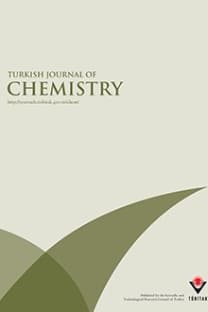Characterization of a Cu$^{2+}$-selective fluorescent probe derived from rhodamine B with 1,2,4-triazole as subunit and its application in cell imaging
Fluorescent probe, rhodamine B, triazole, Cu$^{2+}$
Characterization of a Cu2+ -selective fluorescent probe derived from rhodamine B with 1,2,4-triazole as subunit and its application in cell imaging
Fluorescent probe, rhodamine B, triazole, Cu$^{2+}$,
___
- In conclusion, a novel Cu2+-selective rhodamine B fluorescent probe containing 1,2,4-triazole as subunit was constructed. Cu
- could induce spirolactam ring opening of the rhodamine unit and achieved an “off–on” effect. The probe P can detect as low as 2.3× 10 −7
- M Cu2+. In addition, the probe P was successfully used to detect Cu2+in living cells. 3. Experimental
- Reagents and instruments
- All reagents and solvents are of analytical grade and used without further purification. The metal ions and anions salts employed were NaCl, KCl, CaCl2·2H2O, MgCl2·6H2O, Zn(NO3)2·6H2O, PbCl2, CdCl2, CrCl3·6H2O, CoCl·6H2O, NiCl·6H2O, HgCl2, CuCl2·2H2O, FeCl3·6H2O, and AgNO3.
- Fluorescence emission spectra were conducted on a Hitachi 4600 spectrofluorometer. UV-Vis spectra were obtained on a Hitachi U-2910 spectrophotometer. Nuclear magnetic resonance (NMR) spectra were measured with a Bruker AV 400 instrument and chemical shifts are given in ppm from tetramethylsilane (TMS). Mass spectra (MS) were recorded on a Thermo TSQ Quantum Access Agilent 1100.
- Synthesis of compound P
- Compounds 1 and 2 were synthesized as reported.18,19
- Compounds 1 (0.13 g, 1.0 mM) and 2 (0.496 g, 1.0 mM) were mixed in ethanol (40 mL). The reaction mixture was stirred at 80 ◦
- C for 4 h. After the reaction was finished, the solution was removed under reduced pressure. The precipitate so obtained was filtered and purified with silica gel column chromatography (petroleum ether/acetic ether = 5:1, v:v) to afford P as yellow solid. Yields: 83.4%. MS (ES+) m/z: 609.27 [M + H]+. 1H NMR ( δ ppm, d 6-DMSO):
- General spectroscopic methods
- Metal ions and chemosensor P were dissolved in deionized water and DMSO to obtain 1.0 mM stock solutions, respectively. Before spectroscopic measurements, the solution was freshly prepared by diluting the high concen- tration stock solution with the corresponding solution. For all measurements, excitation/emission slit widths were 5/10 nm and excitation wavelength was 550 nm.
- ISSN: 1300-0527
- Yayın Aralığı: 6
- Yayıncı: TÜBİTAK
Synthesis and biological evaluation of novel fused triazolo[4,3-$a$] pyrimidinones
IKHLASS ABBAS, SOBHI GOMHA, MOHAMED ELNEAIRY, MAHMOUD ELAASSER, BAZADA MABROUK
MASSOMEH GHORBANLOO, SOMAYEH GHAMARI, HIDENORI YAHIRO
Synthesis and biological evaluation of novel fused triazolo[4,3-a] pyrimidinones
Ikhlass ABBAS, Mahmoud ELASSER, Mohamed ELNEAIRY, Bazada MOBROUK
Na LI, Chunwei YU, Yuxiang JI, JUN ZHANG
AKBAR MOBINIKHALEDI, ATISA YAZDANIPOUR, MAJID GHASHANG
Somayeh GHAMARI, Massomeh GHORBANLOO, Hidenori YAHIRO
HATİCE GAMZE SOĞUKÖMEROĞULLARI, TUĞBA TAŞKIN TOK, FEYZA YILMAZ, İSMET BERBER, MEHMET SÖNMEZ
Mehmet SÖNMEZ, İsmet BERBER, Feyza YILMAZ, Tuğba TOK TAŞKIN, Hatice Gamze SOĞUKÖMEROĞULLARI
